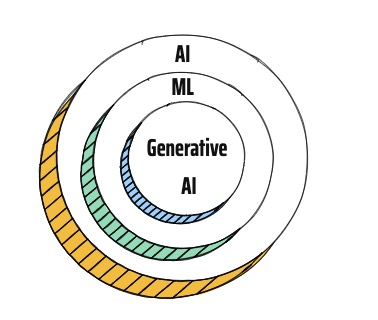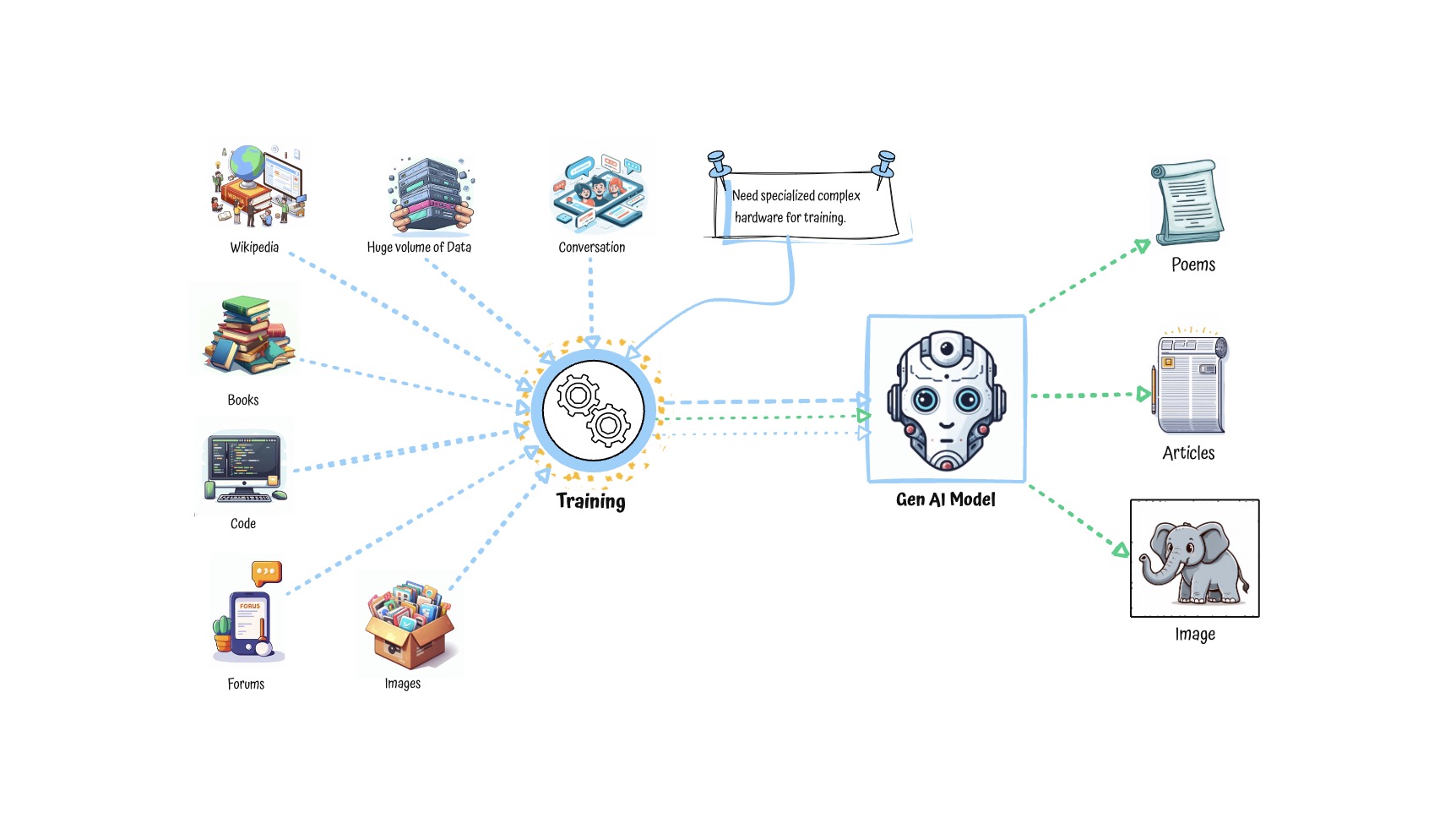Compare AI vs ML #
What is Artificial Intelligence?
- Definition: A branch of computer science focused on building systems that can simulate human intelligence
- Goal: Enable machines to see, understand, learn, and make decisions

AI is All Around Us
- Self-driving Cars: Sense environment and make driving decisions
- Spam Filters: Detect and block unwanted emails
- Fraud Detection: Analyze behavior to flag suspicious transactions
- Recommendation Systems: Suggest music, movies, products based on past activity
- Email Sorting: Categorize emails into Primary, Promotions, and Social tabs
How is Traditional Programming done?
- Scenario: You want to predict house prices
- Traditional Programming: You write explicit rules — “IF location is X AND size is Y THEN price is Z”
How does Machine Learning work?
- What Happens?: ML system that learns from data instead of rules
- Machine Learning: Give examples → ML finds patterns → Predicts outcome
- Power: ML improves as more data is provided
How Machine Learning Works
- Step 1: Feed Data – Provide historical examples
- Step 2: Train Model – ML learns patterns in data
- Step 3: Predict – Use trained model to predict on new data

| Aspect | Artificial Intelligence (AI) | Machine Learning (ML) |
|---|---|---|
| Purpose | Simulate human intelligence | Enable machines to learn from data |
| Scope | Broad — includes reasoning, learning, and problem-solving | Narrower — focused mainly on learning from data |
| Relation | ML is a subset of AI | Part of AI |
| Data Dependency | May or may not use data | Strongly depends on large amounts of data |
What are the Key Steps in Machine Learning Lifecycle? #

Step 1: Data Ingestion
- Collect data from real-world sources
- Examples: User clicks, sales records, logs, images, transaction systems, big data systems, ..
Step 2: Data Preparation
- Clean and transform data
- Examples: Remove duplicates, handle missing values, ..
Step 3: Model Training
- Use training data to build a prediction model
- Use frameworks like TensorFlow, PyTorch, scikit-learn
Step 4: Model Deployment
- Make model available to real-world systems
- Examples: Integrate model into mobile app or website
Step 5: Model Management
- Track model performance over time
- Actions: Retrain with new data
End-to-End Example: Spam Detection
- Ingest: Pull email history
- Prepare: Label spam vs not spam
- Train: Learn patterns from labeled data
- Deploy: Filter incoming emails
- Manage: Keep accuracy high as spam tactics evolve
What is Generative AI? #
Why Generative AI?
- Scenario: Traditional ML models can detect spam or predict house prices. But what if we want the machine to write an email, generate an image, or create a video?
- Generative AI: A special kind of AI that creates new content like text, code, images, and audio — not just make predictions.
- Definition: A subset of Machine Learning that creates original content from patterns it learned
- Goal: Move from consuming data to generating data
- Examples: Writing poems, answering questions, generating software code, creating art

How is Generative AI Different from Traditional ML?
| Aspect | Generative AI | Traditional ML |
|---|---|---|
| Purpose | Create new content (text, images, code, etc.) | Make predictions or classifications |
| Output Type | Original and creative outputs | Structured outputs like labels or numbers |
| Examples | ChatGPT, DALL·E, GitHub Copilot | Fraud detection, stock price prediction |
| Training Data | Requires massive datasets and compute power | Can work with smaller, structured datasets |
| Use Cases | Content generation, summarization, coding help | Forecasting, classification, .. |

How does Generative AI Work?
- Foundation Models Power Generative AI
- Definition: Huge pre-trained models trained on broad data (text, code, images)
- Reusable: One model can handle many tasks (chat, translate, summarize)
- Customizable: Many apps fine-tune foundation models for their specific needs
- Training Foundation Models is Complex
- Massive Datasets: Learn from books, code, web pages, image captions
- Expensive Training: Needs GPUs, TPUs, distributed storage
- Takes Time: Training can take weeks or months, depending on size
- Key Limitations of Foundation Models
- Data Dependency: Garbage in, garbage out
- Model quality depends on training data
- If trained on biased or outdated info, it will produce flawed results
- Knowledge Cutoff: Models freeze in time
- Cannot access real-time data
- Cannot tell you what happened after their training period
- Hallucinations: Confident but incorrect responses
- May generate fake facts, URLs, citations, or statistics
- Bias: Inherits bias from training data
- Can unintentionally favor certain groups over others
- Edge Cases: Uncommon inputs often fail
- Models may behave unexpectedly with unusual or rare queries
- Data Dependency: Garbage in, garbage out
- Reducing Hallucinations with Grounding
- Grounding: Link AI outputs to verified data
- Example: Connect chatbot to trusted company documents
- Benefits:
- Reduces hallucinations
- Provides sources
- Popular Technique – RAG (Retrieval-Augmented Generation)
- Step 1: Search trusted documents
- Step 2: Add findings to the prompt
- Step 3: Let model generate based on that data
- Grounding: Link AI outputs to verified data
How did the ML landscape change after Generative AI? #
ML Landscape Before Generative AI
- 3 Typical Approaches: Prebuilt ML APIs, AutoML tools, or full custom models
- ML APIs: Use ready-made APIs for text, speech, image, or video tasks
- Use Case: Convert customer calls to text using Speech-to-Text API
- Use Case: Detect objects in product images using Vision API
- Use Case: Classify customer reviews as positive or negative
- AutoML: Train custom models without ML expertise by uploading labeled data — platform handles training and deployment
- Use Case: Classify support tickets into categories using labeled examples
- Use Case: Categorize pet images (e.g., dogs vs cats) by uploading a labeled dataset
- Custom Models: Full control for ML teams using frameworks like TensorFlow, PyTorch, scikit-learn — bring your own data and code
- Use Case: Build a custom model to forecast daily sales using historical data
- Use Case: Train a deep learning model for detecting anomalies in financial transactions

Generative AI Brought in New Capabilities
- Foundation Models Introduced: Pre-trained on massive datasets to generate text, code, audio, and images
- Use Case: Generate product descriptions automatically for e-commerce listings
- Use Case: Write code snippets based on natural language prompts
- New Capabilities: Summarization, chat, translation, and content generation via simple APIs
- Use Case: Summarize long customer feedback into short highlights
- Use Case: Translate product manuals into multiple languages
- Models Can Be Tuned Easily: Foundation models can be fine-tuned with your own data to adjust tone, context, or behavior
- Use Case: Fine-tune a chatbot to use your company’s tone and answer product-specific questions
ML Landscape After Generative AI
- Use Pretrained APIs (NO CHANGE) — Use ready-made APIs: text, speech, image, or video tasks
- Use Foundation Models via API (NEW) — New capabilities: chat, summarize, translate, generate code
- Use Case: Summarize long customer feedback into short highlights
- Customize Foundation Models (NEW) — fine-tune on your own data
- Use Case: Fine-tune a chatbot to use your company’s tone and answer product-specific questions
- Train with AutoML (NO CHANGE) — build models without writing code
- Use Case: Categorize pet images (e.g., dogs vs cats) by uploading a labeled dataset
- Build Custom Models (NO CHANGE) — use your own infra and tools if full control is needed
- Use Case: Train a deep learning model for detecting anomalies in financial transactions
Key Shift After GenAI
- Platforms now support both traditional ML and GenAI paths
Managed Services In Different Cloud Platforms for AI and ML #
| Category | Description | AWS | Azure | Google Cloud |
|---|---|---|---|---|
| Use Pretrained APIs | Use ready-made APIs: text, speech, image, or video tasks | Amazon Rekognition (image & video analysis) Amazon Comprehend (text analytics),.. |
Azure AI Vision (image analysis) Azure AI Language (text analysis), .. |
Google Cloud Vision AI (image analysis) Google Cloud Natural Language AI (text analysis),.. |
| Use Foundation Models via API | New capabilities: chat, summarize, translate, generate code | Amazon Bedrock | Azure AI Foundry | Vertex AI Model Garden |
| Customize Foundation Models | Fine-tune foundation models on your own data (cloud-specific & open-source models such as Anthropic Claude, Meta Llama, & Mistral) | Amazon Bedrock | Azure AI Foundry | Vertex AI Model Garden |
| Train with AutoML | Build models without writing code | Amazon SageMaker Autopilot | Azure Machine Learning Automated ML | Google Cloud AutoML |
| Build Custom Models | Platforms for building, training, and deploying custom ML models using TensorFlow,... | Amazon SageMaker | Azure Machine Learning | Vertex AI Custom Training |